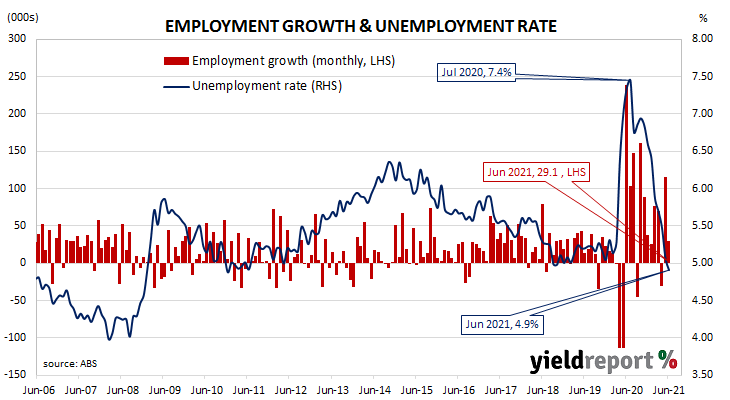Summary: Total employment increases by 29,100 in June; rise more than expected; “many industries reporting labour shortages”; participation rate steady, near all-time high; fewer people seeking work with larger available workforce sends jobless rate to 4.9%; fewer part-time, more full-time jobs; aggregate work hours falls 1.8%; Victorian lockdown reflected in hours worked, underemployment; underemployment rate up from 7.4% to 7.9%.
Australia’s period of falling unemployment came to an end in early 2019 when the jobless rate hit a low of 4.9%. It then averaged around 5.2% through to March 2020, bouncing around in a range from 5.1% to 5.3%. Leading indicators such as ANZ’s Job Ads survey and NAB’s capacity utilisation estimate suggested the unemployment rate would rise in the June 2020 quarter and it did so, sharply. The jobless rate peaked in July 2020 but fell below 7% a month later and then continued to trend lower.
The latest Labour force figures have now been released and they indicate the number of people employed in Australia according to ABS definitions increased by 29,100 in June. The rise was considerably less than May’s revised increase of 115,100 but more the generally expected increase of 20,000.
Westpac senior economist Justin Smirk said the figures are consistent with recent rises in various leading indicators of employment. Furthermore, he said, “Firms across many industries are reporting labour shortages and are experiencing difficulties in finding suitable employees.”

Domestic Treasury bond yields fell noticeably on the day following similar moves by US Treasury bond yields in overnight trading. By the end of the day, the 3-year ACGB yields had shed 2bps to 0.34% while 10-year and 20-year yields each finished 6bps lower at 1.29% and 1.86%.
In the cash futures market, expectations of any change in the actual cash rate remained soft. At the end of the day, contract prices implied the cash rate would gradually rise from its current rate of 0.03% to around 0.22% by November 2022.
The participation rate remained steady at 66.2%, just below March’s record high of 66.3%, as the total available workforce increased by 7,100 to 13,833,300. The number of unemployed persons fell by 22,000 to 679,100; the lower unemployment number in conjunction with more people in the workforce led to a drop in the unemployment rate from 5.1% to 4.9%.

